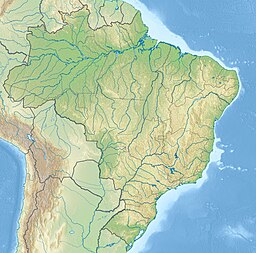Sistema Cantareira
| Sistema Cantareira | |
|---|---|
 Paiva Castro Dam, in Mairiporã | |
| Coordinates | 23°19′48″S 46°40′44″W / 23.33000°S 46.67889°W |
| Catchment area | 2,307 km2 (891 sq mi) |
| Managing agency | Sabesp |
| First flooded | 29 June 1973 (Paiva Castro and Atibainha dams) |
| Water volume | 990 million cubic metres (800,000 acre⋅ft) |
| Settlements | Bragança Paulista, Piracaia, Vargem, Joanópolis, Nazaré Paulista, Franco da Rocha, Mairiporã, Caieiras and São Paulo |
 | |
Sistema Cantareira (Cantareira system) is a water supply system in the state of São Paulo, Brazil. It is composed of five interconnected reservoirs that provide water to 9 million people in the São Paulo metropolitan area.[1] The system is managed by Sabesp, São Paulo's state water management company.
History
[edit]By 1960, the São Paulo state government, concerned about the high population growth of the city of São Paulo and neighboring towns, whose population has totaled 4.8 million inhabitants, decided to enhance the water supply of the Metropolitan Region of São Paulo, planning the construction of several reservoirs in the headwaters of Piracicaba River basin, thus beginning the Cantareira System.
In 1966, work began on the construction of reservoirs on the Juqueri River (today Paiva Castro), Cachoeira, and Atibainha. In 1976, the Jacarei and Jaguari reservoirs were started by adding a capacity of 22,000 liters, second to the system.[2]
2014–17 water crisis
[edit]This section needs to be updated. (December 2018) |
In 2014, low rainfall in the state of São Paulo led to a severe drought. The Cantareira system's water level has fallen constantly, leading to water shortages in some areas of the city.[1] Among the measures taken by Sabesp to face the problem are reducing the water pressure to residences, a bonus for customers who save water, and exploring the reservoir's ground water.
With the lack of rain after November 2014, a severe drought situation developed. By February 2015, only 6% of Cantareira's capacity was filled.[3]
References
[edit]- ^ a b Phillips, Dom (21 May 2014). "São Paulo faces a critical water shortage as the World Cup prepares to kick off". The Guardian. Retrieved 3 August 2014.
- ^ SOLIA, Mariângela; FARIA, Odair Marcos; ARAÚJO, Ricardo (2007). Mananciais da região metropolitana de São Paulo. São Paulo: Sabesp.
- ^ "Brazil drought prompts drastic measures to save water". Al Jazeera. February 14, 2015. Retrieved February 14, 2015.
- "Reservoir Hogs; Sao Paulo's Water Crisis". The Economist. December 20, 2014. Retrieved January 3, 2015.

